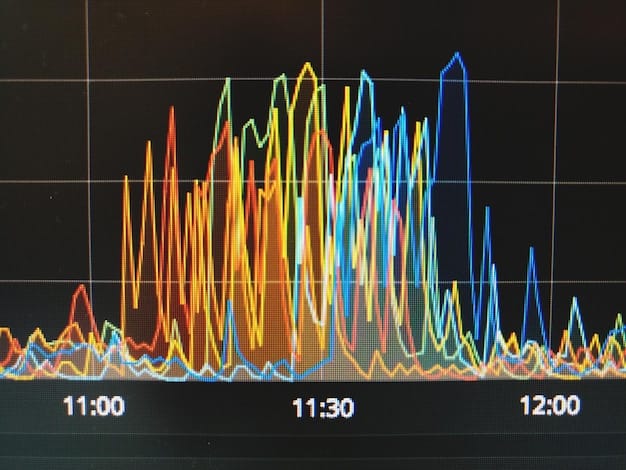Lithium Price Surge: Impact on Electric Vehicle Battery Costs in the US

Analyzing the impact of rising lithium prices on the cost of electric vehicle batteries in the US reveals a complex relationship, where increased lithium costs directly influence battery production expenses, potentially raising the overall price and affecting the adoption rate of electric vehicles in the American market.
The electric vehicle (EV) market in the US is rapidly evolving, but its growth is significantly influenced by the fluctuating costs of raw materials, particularly lithium. Understanding Analyzing the impact of rising lithium prices on the cost of electric vehicle batteries in the US is crucial for consumers, manufacturers, and policymakers alike. This article explores the key factors driving lithium prices and their subsequent effects on EV battery production and affordability.
Analyzing the Lithium Market Dynamics
The lithium market has experienced significant volatility in recent years. Understanding the dynamics of supply and demand is essential to grasp why lithium prices are fluctuating. Several factors contribute to this dynamic, impacting the entire electric vehicle supply chain.
Global Lithium Demand
The demand for lithium is primarily driven by the increasing adoption of electric vehicles. As more consumers switch to EVs, the need for lithium-ion batteries grows exponentially. This demand is further amplified by the energy storage sector, which uses lithium-ion batteries for grid stabilization and renewable energy storage.
- Increased EV sales globally are the primary driver.
- Government incentives promoting EV adoption boost demand further.
- Expansion of energy storage systems utilizing lithium-ion technology adds to the demand.
Lithium Supply Constraints
Despite abundant lithium reserves, several constraints limit its supply. Mining and processing lithium is a complex and time-consuming process. Geopolitical factors, environmental regulations, and infrastructure limitations further complicate the supply chain.
- Limited number of operational lithium mines and processing facilities.
- Geopolitical instability in key lithium-producing regions.
- Environmental concerns regarding lithium mining practices.

In conclusion, the balance between rising demand and constrained supply significantly influences lithium prices. Understanding these dynamics is crucial for predicting future trends and their impact on the EV battery market.
Impact of Lithium Prices on Battery Manufacturing Costs
Lithium is a key component in electric vehicle batteries, making up a significant portion of the overall cost. Fluctuations in lithium prices directly affect the manufacturing expenses of these batteries. Therefore, understanding this relationship is vital for analyzing the overall cost of EVs.
Direct Cost Impact
The cost of lithium directly influences the bill of materials (BOM) for battery manufacturers. When lithium prices increase, the cost of producing each battery also rises, impacting profit margins and potentially leading to higher prices for consumers.
- Lithium accounts for a substantial percentage of battery material costs.
- Price increases directly translate to higher battery production expenses.
Indirect Cost Impact
Beyond direct material costs, rising lithium prices can also have indirect effects. Manufacturers might seek alternative, less expensive materials, potentially affecting battery performance or lifespan. Additionally, the increased cost pressures can lead to investments in more efficient recycling and extraction technologies.
- Manufacturers may explore alternative battery chemistries to mitigate lithium costs.
- Increased focus on lithium recycling and resource efficiency.
In summary, the impact of lithium prices on battery manufacturing costs is profound, affecting both direct material expenses and influencing strategic decisions within the industry, making it very important information when analyzing the impact of rising lithium prices on the cost of electric vehicle batteries in the US.
Electric Vehicle Battery Technology and Lithium Usage
Different electric vehicle battery technologies utilize lithium in varying amounts. Understanding these differences is essential for assessing how lithium price fluctuations impact the cost of different types of EV batteries. The technology used and how much lithium is used determine the extent of that impact.
Lithium-Ion Battery Chemistries
Lithium-ion batteries come in various chemistries, each with its own composition and performance characteristics. These chemistries, such as Lithium Iron Phosphate (LFP), Nickel Manganese Cobalt (NMC), and Nickel Cobalt Aluminum (NCA), use different amounts of lithium and other materials.
NMC and NCA batteries tend to use more lithium compared to LFP batteries. When lithium prices rise, the cost of NMC and NCA batteries may increase more significantly, impacting vehicle pricing.
Impact on Battery Performance
The choice of battery chemistry also affects EV performance. Batteries with higher lithium content often provide better energy density and longer driving ranges. However, these batteries may also be more expensive due to the higher cost of lithium.
Manufacturers often need to balance the cost of lithium with the desired performance characteristics of their EVs. Finding the right balance is not only fiscally important but also critical to optimizing performance metrics.

Overall, the type of battery technology used and its lithium content considerably affect the cost and performance of electric vehicles. This is all very important when analyzing the impact of rising lithium prices on the cost of electric vehicle batteries in the US. As lithium prices fluctuate, manufacturers must carefully consider these factors to optimize their battery designs.
Strategies for Mitigating Lithium Price Impact
Given the potential volatility of lithium prices, various strategies are being explored to mitigate the impact on electric vehicle battery costs. Manufacturers and researchers are actively working to find more efficient ways to use lithium and develop alternative battery technologies.
Diversifying Lithium Supply
Diversifying the sources of lithium supply is a crucial strategy for reducing price volatility. This involves exploring new lithium mining projects in different regions and establishing strategic partnerships with multiple suppliers. This mitigates the risk of supply disruptions.
Investing in Recycling Technologies
Recycling lithium from end-of-life batteries is another promising approach. Advanced recycling technologies can recover valuable materials, including lithium, cobalt, and nickel, reducing the need for newly mined resources. This also reduces the environmental impact of battery production.
- Development of efficient recycling processes to recover lithium.
- Incentives for battery recycling programs.
Researching Alternative Battery Chemistries
- Development and deployment of sodium-ion batteries.
- Research into solid-state batteries with lower lithium content.
In navigating the fluctuations of lithium prices, the EV industry is relying on innovation to find ways to lessen the economic impact. Diversifying supply, investing in recycling, and embracing new battery technologies are the key strategies shaping the future of EV battery production.
Government Policies and Incentives
Government policies and incentives play a significant role in shaping the electric vehicle market and influencing lithium demand and supply. Supportive policies can accelerate EV adoption, while incentives can help offset the higher costs associated with lithium-ion batteries. These policies and incentives serve a critical role in easing the transition to electric vehicles.
EV Adoption Incentives
Various governments offer incentives to encourage consumers to purchase electric vehicles. These incentives can include tax credits, rebates, and subsidies, reducing the upfront cost of EVs and making them more accessible to a wider range of buyers.
Incentives play a crucial role in the purchasing choices consumers make when considering a switch to EV. They help offset a higher upfront cost and increase their appeal to budget-minded drivers. The incentives offered, and the longevity of such programs can increase consumers’ desire.
Support for Domestic Lithium Production
Governments are also investing in domestic lithium production to ensure a stable supply of this critical material. This can involve supporting lithium mining projects, providing funding for research and development, and streamlining the regulatory approval process.
- Direct investment in lithium mining and processing facilities.
- Tax incentives for companies involved in lithium production.
Government policies and incentives are essential for fostering growth in the electric vehicle market. They can help mitigate the impact of rising lithium prices and promote the development of a sustainable EV ecosystem; all of which is factored into the analyzing the impact of rising lithium prices on the cost of electric vehicle batteries in the US.
Future Outlook for Lithium Prices and EV Battery Costs
Predicting the future of lithium prices and their impact on electric vehicle battery costs is complex, which makes analyzing the impact of rising lithium prices on the cost of electric vehicle batteries in the US important. Several trends and factors could influence the trajectory of lithium prices in the coming years.
Supply and Demand Projections
Future lithium prices will largely depend on the balance between supply and demand. Experts predict continued strong demand for EVs, driven by tightening emissions regulations and growing consumer awareness. However, the pace at which lithium supply can increase to meet this demand remains uncertain.
If supply cannot keep pace with demand, lithium prices could remain elevated or even increase further. Conversely, increased production and recycling efforts could help stabilize or reduce prices. The direction the market takes may involve unpredictable factors such as geopolitical events.
Technological Advancements
- Solid-state batteries with lower lithium content.
- Lithium-sulfur batteries with improved energy density and lower cost.
The cost of electric vehicle batteries could also be influenced by advances in manufacturing and recycling technologies. Improved battery production processes can reduce waste and lower overall costs. Efficient recycling technologies can recover valuable materials and reduce the reliance on newly mined lithium.
| Key Point | Brief Description |
|---|---|
| 📈 Rising Lithium Demand | Increased EV adoption and storage systems drive up lithium demand significantly. |
| 💰 Impact on Battery Costs | Higher lithium prices directly increase EV battery production costs. |
| ♻️ Recycling & Alternatives | Recycling and development of alternative battery chemistries offer mitigation. |
Frequently Asked Questions
▼
Lithium prices are increasing due to rising demand from the EV and energy storage sectors, coupled with supply constraints related to mining and geopolitical factors.
▼
Higher lithium content in batteries often leads to better energy density and longer driving ranges, though it may also increase battery costs.
▼
Alternative solutions include sodium-ion batteries, lithium-sulfur batteries, and solid-state batteries, each aiming to reduce lithium dependence and costs.
▼
Governments can provide incentives for EV adoption, invest in domestic lithium production, and support research and development for alternative battery technologies.
▼
Lithium recycling reduces the need for newly mined resources by recovering valuable materials, reducing the environmental impact and stabilizing supply.
Conclusion
Analyzing the impact of rising lithium prices on the cost of electric vehicle batteries in the US reveals a complex interplay of market forces, technological innovation, and government policies. While lithium price fluctuations pose challenges, ongoing efforts in supply diversification, recycling, and alternative battery technologies offer promising pathways toward a more sustainable and affordable EV future. The US EV market is poised to adapt as stakeholders navigate these dynamic trends.





